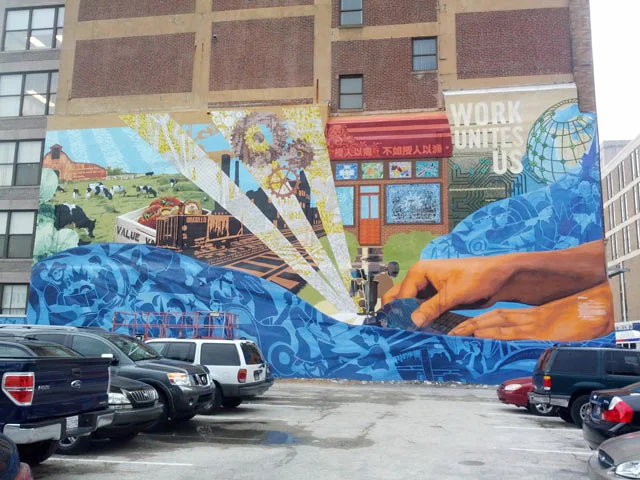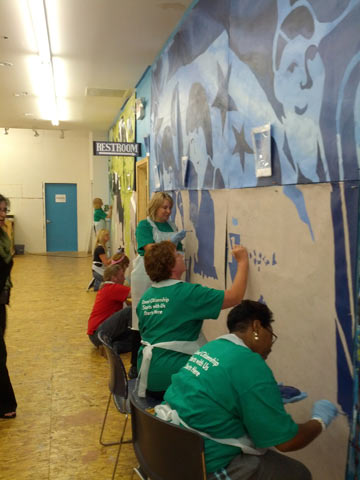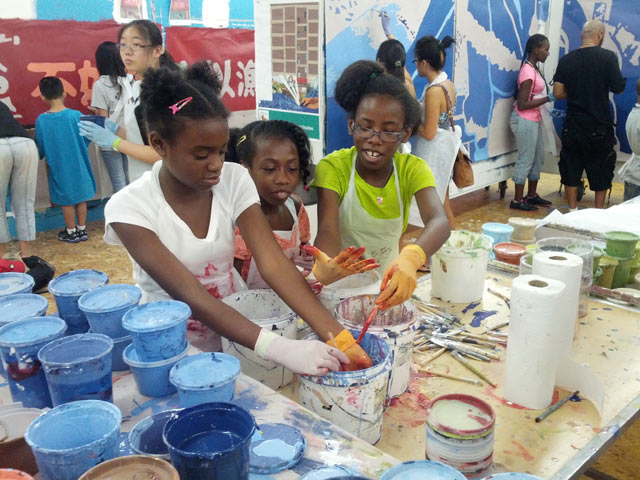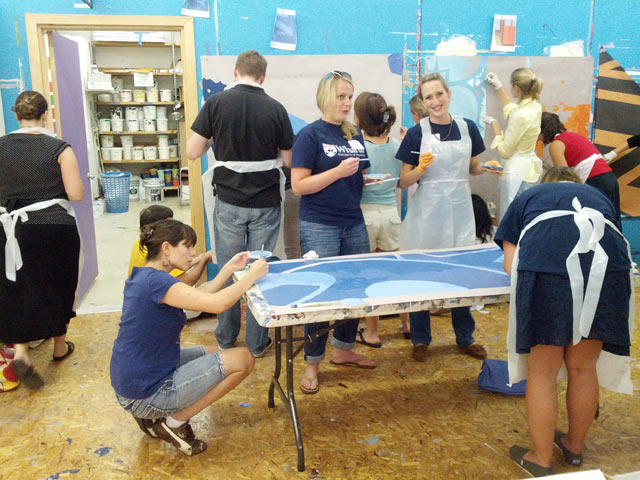













































In 2012 I collaborated with Social Impact Studios on “How We Fish”, the mural's title refers to the proverb: “Give a man a fish and he eats for a day. Teach a man to fish and he eats for a lifetime.”

Located on the Archworks Building at 125 North 8th Street, “How We Fish” focuses on the value and meaning of work for individuals and communities. The building was once the home for the Women's Garment Worker's Union.

7 citywide workshops were held, facilitated by the Penn Project for Civic Engagement, to get people talking about the changing face of work in Philadelphia, and its meaning to individuals and families.

The workshops generated an immense output of thoughts and ideas. Our team developed a creative brief, a document that has transformed over time lending insight into our thought process with each workshop, and the design's evolvution. Click here to view our brief.

Through our notes, we began to categorize work into separate economies throughout Philadelphia's history: Agricultural, Industrial, Merchant-Based, and Knowledge-Based Economies.

Each "Economy" featured in the design showcased a vibrant stained glass element, as well as key words that came up in various workshop discussions.

Recordings were made at each meeting to capture peoples quotes, many of which became immortalized into the mural as paint or stained glass.

While there is a central image of one “worker” on the mural, the images of work through different economies and as shared between the interconnected fabric of society shows how much we must rely on each other to be successful at work and in our lives.

The blue fabric pattern, weaves another narrative about the interconnectivity of work throughout the economies. People in numerous professions are dependent on the work of their neighbor. These connections are symbolized by the "bursts" throughout the blue cloth.

Our overall message “Work Unites Us” continued to ring true." Our artist team was now united in the challenge of translating these ideas, and combining our visual styles into a single piece.

We began by designing the mural on our own. Then discovering the commonalities in our concepts. Ennis of Social Impact, created a poster design in her signature style. The idea of depicting various economies can be seen in this initial draft.

My initial draft of the design included a variety of visual ideas. Some found its way to the wall, such as the use of silhouetted figures symbolizing a vanishing workforce. The history of the building and the Chinatown locale made the garment worker's hands an appropriate image.

We began to combine and refine our ideas, adding layers of complexity to the economies. "Work Unites Us" was to be painted as a old faded factory logo on a brick surface.

The final design revision. Certain restrictions kept us from being overly ambitious in travelling up the building facade. We had to limit ourselves to 3000sq ft only.

I had assembled a fantastic mural and mosaic team during the summer to complete this work. I moved my studio into Mural Arts Tour Office in the Gallery in Market East, and we began prepping for a summer of glass cutting and volunteer paint days.

Seven major paint days were held in that Gallery space which saw as many as 400 individual volunteers painting the mural.

The project was underwritten by Citizen's Bank who had a paint day of their very own. Deborah was involved with the project from the beginning discussions, she had input into the design, and now she's volunteered during several paint days.

MAP Tours also worked with the Wharton Business school that summer. Students from all over the world came to volunteer on the project. This particular group came from South Korea.

People were able to take ownership in their particular sections; painting in the same spot to completion for hours on end.

My lead assistant, Briana, took care of all the prep work for the workshops, as well as touching up the panels afterword. Which freed me up to focus on the massive about of glasswork we had to do.

It wasn't uncommon for a group to finish off a section in 4 hours, and then pose for pictures to remember which panels of the finished mural were their's.

For my crew, the biggest challenge was blending the painted colors on the cloth, and have the final result look like a printed pattern on fabric.

On Labor Day, we held one last final paint day outdoors in front of the wall. The volunteers could see their panels' placement on the wall alongside the installed mosaic. This event was envisioned as a kickoff for the mural's installation.

It poured that day, but we still saw close to 75 volunteers come out and take part. All of the panels were painted under tents.

On that rainy day, volunteers painted a record 12 5'x5' panels. The most for the project during one event, and the most I had ever seen at any of my paint days.

People brought their families, there was food and music. The event was a huge success in spite of the weather.

Since we were covering an older mural, I had to spend my first week plotting the placement of the mosaic, and then grinding away the paint from the wall to lay our glass on fresh stucco.

We cut close to 700sq ft of glass for the mural. It was a massive undertaking that took close to 4 months to fabricate, and 3 days to install. Visit the Glass section of this site for photos of that process.
